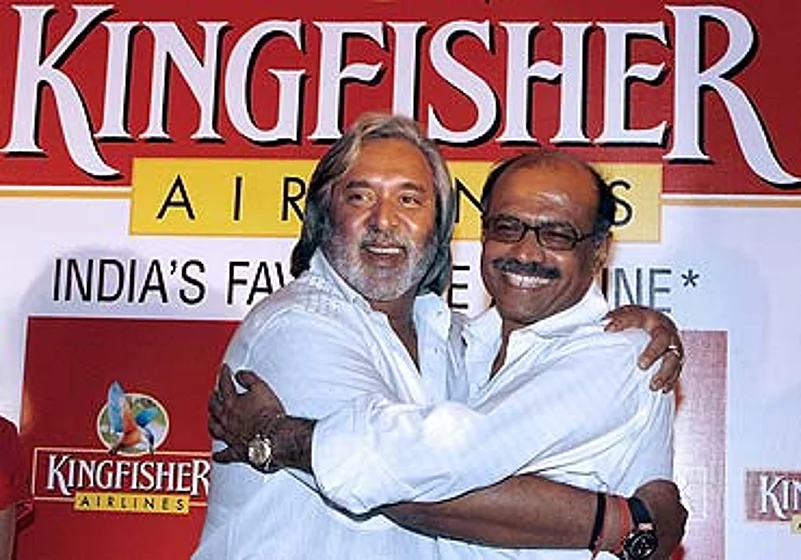- Customers will have to be realistic, be ready to pay prices where an airline can reasonably cover cost of operation
- Most airlines admit that while pricing strategies will ensure load factor targets, the Re 1 fare is out
- A hike in low-cost fares may affect volume growth; estimates indicate the growth may halve to 25-30%
- Low-cost airlines will continue to offer tickets at varying prices depending on when you have booked the tickets
***

So, like in the case of Kingfisher and Air Deccan, it makes an excellent case for the upmarket Paramount to acquire a low-cost airline, GoAir, which largely operates in the western region and offers tremendous synergies in terms of infrastructure like parking bays and slots. At the same time, like Air Deccan, GoAir seems to be in a financial crisis and has been scouting for a good influx of funds from strategic investors. Like Air Deccan, which had mandated Edelweiss Capital to help raise funds, GoAir was rumoured to be wooing private equity firms like US-based gatx Corporation and Wellington Management, as well as other existing airlines (Jet Airways).
But the big question on everyone's mind is whether the recent spate of mergers—including Jet Airways-Air Sahara and Air India-Indian—signal the end of ridiculously low fares that lured air travellers? At a financial level, it's clear that it was the cheap tickets like Rs Nil plus taxes in the case of Air Deccan and the two lakh tickets issued by SpiceJet at 99 paise each in recent months that has been bleeding the airlines. The loss has been to the extent of Rs 400-650 per passenger per flight. Therefore, it is not surprising that all the existing airlines have huge accumulated losses.
The new acquirers are expected to change that scenario and, thus, experts agree that the days of unreasonably low-cost travel are over. Explains Jayesh Desai, director, Ernst & Young, "The Indian customer will have to become more realistic and be ready to pay the price at which an airline can reasonably cover its cost of operation unlike before where the market was seeing huge undercuttings and, hence, mounting losses. " Even Capt Gopinath, the king of low-cost airlines, says "we'll all become sensible now and ticket prices across the spectrum will rise to the tune of Rs 500-600 each".
The trend is already visible on the ground. For example, Jet Airways has refused to position its new airline, Jetlite, as a low-cost one. Instead, it plans to position the latter as a niche player with fares ranging between low-cost and full-service airlines (like Jet and Kingfisher). Explains Gary Kingshott, acting CEO, Jetlite, "At this stage, consolidation is more helpful than failing airlines. In an environment of substantial oversupply, the pressure to get any returns drove operators to sell (tickets) below costs. This is not sustainable and consolidation is likely to bring some price stability, but only when demand-supply come much closer into a balance."
Kingshott is emphatic that although Jetlite will have lower fares, it will be positioned as a value-based airline. "Although pricing strategies will be employed to meet load factor targets, the Re 1 fare will not be a part of our approach," he says. Reveals P.P. Singh, COO, Air India Express, India's first international low-cost carrier, "We will strategise so that we are profitable from day one without pricing below costs, which is what the likes of Air Deccan did." But he does hint that fares may be still 15-20 per cent cheaper than the competition. Even in the domestic sector, Singh says that ticket pricing will be "extremely competitive without resorting to undercutting our costs".
Now if this turns out to be true, it will also impact the growth in the civil aviation sector. Especially in a price-sensitive market like India. Since the Centre for Asia Pacific Aviation(CAPA) estimates that by 2010, 70 per cent of Indian air passengers will travel in low-cost airlines, higher fares may dent demand. Agrees Kapil Kaul, CEO (Indian subcontinent), CAPA, "Given that due to consolidation prices may move northwards, there might be a slowdown in passenger volume growth from the existing 45-50 per cent to 25-30 per cent. Post-mergers, pricing power will be restored and the $12-15 deficit carriers were incurring per seat per flight will be ruled out."
To end on an optimistic note, cheap tickets will still be available. So you may still travel Delhi-Mumbai at Rs 1,000 or Rs 2,000 two-way. It's just that the Rs Nil and Re 1 era is over. As Gopinath explains, "Low-cost flights will still have passengers travelling by paying Rs 300, Rs 1,200, Rs 5,000 but also those paying Rs 12,000." As before, it'll depend on whether you have purchased tickets well in advance, or over the counter at the last possible minute. "The only difference being that with consolidation, back-end synergies will rule out the need for any airline to aggressively price below their operational costs."
So for all low-cost travellers, we have a simple advice: don't feel disheartened for many of you will still travel cheap. Say it like this. "Welcome to Flight 001. Please ensure the tray table is stowed, your seat belt is fastened and the seat is back in the upright position." And don't worry, you may not even need to use your credit card, the fares will continue to remain in the range you can afford to pay in cash. "Please sit back, relax and enjoy the flight...."






















